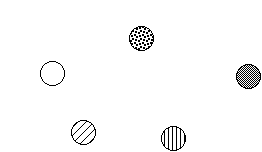
<<Back to Cognition Class Home Page
---------------------------------------------------------------------------------------
Wednesday, April 8
ABSTRACTS
A good abstract:
(1) is well organized. Start with the essential point, and then talk about other important things
(2) Always makes a distinction between EXAMPLES and CONCEPTS. Use TITLES. If the title is "Metaphors in cognitive psychology" probably information about metaphors in general are more central than more specific information about a particular type of metaphor.
(3) in this particular abstract, was important to specify: What a metaphor is, what is the advantage of metaphors, what are the problems associated to the use of metaphors in science.
-------------------------------------------------------------------
Experiment 1
-------------------------------------------------------------------
CONCEPT OF REPRESENTATION (MARR)
"A representation is a formal system that describe certain entities or types of information, together with a specification of how the system does this."
(Marr, 1982, p. 20)
What is a "formal system"?
A FORMAL SYSTEM is a group of symbols with rules for putting them together
(for example, the Arabic or the binary numerical systems)

-------------------------------------------------------------------
An important aspect of cognition and how the brain is related to our cognitive activity is that of REPRESENTATION. How do we represent the external world? How do we represent concepts?
Representations in the brain are called COGNITIVE CODES.
Remember the PET experiment on word representation that we described on Friday.
In that experiment, some regions of the brain were activated by particular types of information. For example, false fonts, that only had visual features information, activated a small posterior right region. String of consonants, that had visual information and letter information, activated a new posterior region. False words that responded to orthographic rules activated a left posterior region, and finally real word activated region in the temporal lobe.
One possible conclusion from these results is that our brain represent words using different and separate cognitive codes that describe particular aspects of the word (for example the visual aspect or the meaning).
The codes that the PET study was trying to distinguish were very specific.
In more general terms, the representation of a word needs at least three codes : VISUAL, PHONOLOGICAL, and SEMANTIC.
The visual code is related to the visual perceptual representation of the word (or any other object). The phonological code is related to the sound of the word and the semantic code is related to the meaning of the word.
For example, when we see the word "pint" we can consider the visual aspect of the word (is there a letter with a thicker segment, is the word written in upper or lower case ?), the phonological aspect of the word (does "pint" rhymes with lint?) or semantic aspects (is a pint less than a quart?) In each instance, a different mental representation or code of the word "pint" is used to reach the appropriate answer.
Will we study later, when we talk about language, that the process that allows us to connect a word with its meanins is called LEXICAL ACCESS.
Some researchers, for example David LaBerge e Jay Samuels, think the different codes are independent representations, but that they are strongly interconnected, so that visual representation affect phonological representation, and vice versa, and semantic representation may affect visual or phonological representation.
TOP-DOWN AND BOTTOM-UP PROCESSES
-------------------------------------------------------------------
Results of Experiment 1
Functional significance of cognitive codes
---------------------------------------------------------------------------------------